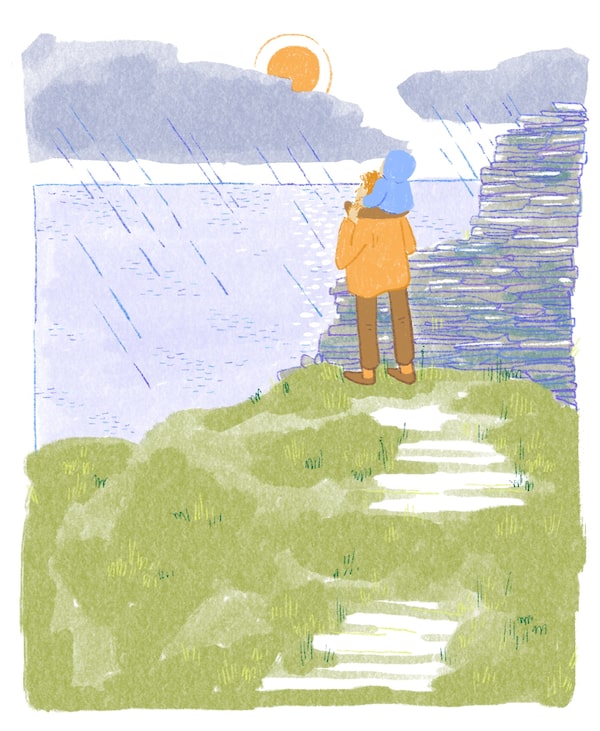First Person is a daily personal piece submitted by readers. Have a story to tell? See our guidelines at tgam.ca/essayguide.

Illustration by April Dela Noche Milne
My wife and I had decided on Ireland for our first big family trip. Though many branches in our family trees stem from Ireland, my motivation for going had nothing to do with exhuming all that history. I just wanted an uncomplicated, memorable vacation. And yet, the feeling that I was visiting my ancestral home – that I had an ancestral home – found me anyway.
It’s been about 170 years since my Irish ancestors left County Carlow for Canada. But it might as well be 1,000. I don’t go for the whole green-beer-and-Guinness frenzy on St. Patrick’s Day. Irish pubs in Ontario don’t inspire me much. I’m so-so on U2. The most “Irish” thing about me is a ginger beard and a casual taste for whisky. My excitement for this trip was firmly rooted in the opportunity to drive a standard transmission on the wrong side of the road for a couple of weeks.
We arrived in Dublin bleary-eyed from the overnight flight with our two kids, aged 5 and 15. The rain came down and after picking up our rental car, we headed west to hike around the rocky landscapes of County Clare. When I wasn’t shifting gears and navigating roundabouts, I was doing double-takes at the familiar faces I spotted at rest stops and restaurants. Wherever we went, I felt an undeniable sense of kinship with strangers. Prospective cousins, aunts and uncles seemed to be everywhere.
It wasn’t just the faces that looked like they were pulled out of my family’s photo albums. I felt at ease with the conversational shorthand here, too and the mutual appreciation for a self-deprecating joke. I sometimes experience this at home in Canada, but finding it across the Atlantic in a country I’ve never before visited was a strange experience.
In a tourism kiosk at the Cliffs of Moher, I looked up my last name and saw it in the county census results from the early 1900s. Later, in a small plaza, I saw my surname written in big letters on a furniture storefront. I’ve never seen “Minogue” displayed in public like this. The one notable exception, of course, would be the entire pop music career of Kylie Minogue.
I’ve recently learned the word “anemoia” means nostalgia for a time or a place you’ve never known. For me, the word conjures the kind of longing I encountered on this trip. I’ve never experienced a longing to know Ireland or even my family’s genealogy beyond a couple of generations. But during an hour-long ferry voyage to Inishmore Island in Galway Bay, with the North Atlantic waves knocking us about, I felt a desire to mend the connection to my ancestors.
It was mid-March, the earliest days of the tourist season on the Aran Islands. Some businesses on Inishmore were just opening for the year. We biked into town from our mostly empty B&B, skirting around the seaside through alternating waves of sun and rain. The few pubs near the docks were overflowing with rugby fans savouring a win over England. Over lunch, I wondered about life as a local and whether any Minogues had ever made it this way.
One day, when the rain got worse, we opted for a tour bus to take us across the island to Dún Aonghasa, a 3,000-year-old stone fort perched at the edge of a 100-metre cliff. The weather was too much for my youngest, so I covered him in a poncho and lifted him onto my shoulders to make the short hike up the hill.
As I navigated the outcroppings of limestone everywhere, I started to feel something akin to a “runner’s high” – a blast of endorphins that allowed me to forget the 40 pounds wiggling on my neck and welcome the slashing rain and wind. It felt good that this was tough-going. The past few years of inactivity, not to mention the normal grind of parenting, have made me hungry for mini-challenges like this.
By the time we entered the innermost ring of the fort, I was swimming in enthusiasm for our trip. A few other off-season travellers were up there with us, posing for photos or mounting the central stone platform – a stage, perhaps, for unknowable Bronze Age ceremonies.
Certain places can give you chills. They emit a sense of history or inspire you to search for that history within yourself. The experience is difficult to articulate, let alone capture with a selfie in the rain.
Seeing the unsettled ocean stretch out before us, the unguarded stone cliff daring me to get closer, I felt perfectly calibrated and in the moment. What if, I wondered, I’m standing in a place recognized by some primal knot in my genes? Dún Aonghasa radiated with meaning I couldn’t understand but sensed was valuable to me. For the first time in my life, I could personalize something ancient. I leaned back against a stone wall for a minute or two, my son gripping the sides of my head. The rain crackled against his poncho.
We went back down the hill and found a small cafe packed with other tourists. I devoured a bowl of chowder and hunks of dark, sweet bread. I felt drunk from the experience and was hungry to understand it better. I felt that I belonged.
Yes, Ireland had many memorable green vistas. Yes, its castles and ruins were stunning. The food, the drink, the family-friendly wandering – it was all great for us. But it was a pile of rocks on an oceanside cliff that gave me the genealogical awakening I needed.
Sean Minogue lives in Toronto.